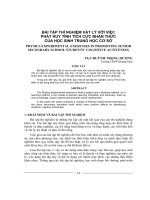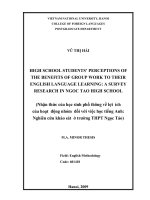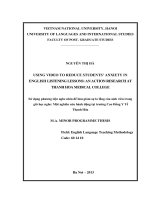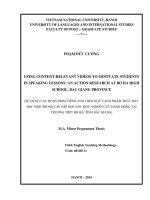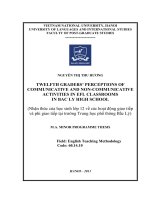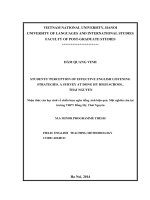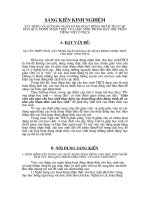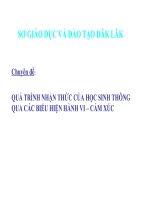Nhận thức của học sinh lớp 11 về chiến lược học đọc – một nghiên cứu mô tả ở trường cấp 3 yên viên
Bạn đang xem bản rút gọn của tài liệu. Xem và tải ngay bản đầy đủ của tài liệu tại đây (1.77 MB, 59 trang )
iii
LIST OF TABLES
Table 2.1. Learning strategy definition and classification (O’Malley and Chamot,
1990:119)
Table 4.1. Analysis of questionnaires: Question 1
Table 4.2. Analysis of questionnaires: Question 2
Table 4. 3. Analysis of questionnaires : Metacognitive reading strategies
Table 4.4: Analysis of questionnaires : Cognitive reading strategies
Table 4.5. Illustrates responses concerning two subtypes of social/affective strategies
Table 4.6. Analysis of interviews : Question 1
Table 4.7. Analysis of interviews : Question 2
Table 4.8: Analysis of interviews: Question 3
iv
ABSTRACT
“Strategic learning is the key to student success in any endeavor
I view learning by strategies as the foundation for lifelong learning”
(P. Hardin in Anderson, 1999:73)
The important role of English reading comprehension is apparent for any students who
have a good command of English. Good reading comprehension not only widens students’
knowledge but also fulfils other skills. For non English major students in Yen Vien high
school, reading has been paid more attentions to as they have to take the examinations which
are grammar-and reading-based. However, they have encountered a lot of difficulties in
reading skills. Language reading strategies are among the main factors that help determine
how - and how well - our students learn a second or foreign language.
This study aims to investigate the reading awareness of 11th grade students in Yen
Vien high school. The result of the study varies among good and poor English readers. This
study has also given some suggestions to reduce their reading difficulties and enhance
students’ reading capacity by equipping them with some reading strategies that help students
obtain desirable results in learning reading.
v
TABLE OF CONTENTS
Declaration………………………………………………………………………
i
Acknowledgements……………………………………………………………..
ii
List of Tables…………………………………………………………………….
iii
Abstract…………………………………………………………………………...
iv
PART 1: INTRODUCTION
1.1. Statement of the problems and rationale of the study…………………………….
1
1. 2. Aims of the Study……………………………………………………………….
3
1. 3. Research Questions……………………………………………………………....
3
1. 4. Research Methodology…………………………………………………………..
3
1. 5. Scope of the Study……………………………………………………………….
4
1. 6. Significance of the study………………………………………………………...
4
1. 7. Design of the Study………………………………………………………………
4
PART 2: DEVELOPMENT
CHAPTER 1: LITERATURE REVIEW
2.1. What is Reading and Reading Comprehension?...................................................
6
2.1. 1. What is Reading?..............................................................................................
6
2.1.2. What is Reading Comprehension?....................................................................
7
2. 2. Classification of reading………………………………………………………..
8
2.2.1. According to manner………………………………………………………….
8
vi
2.2.2. According to the purposes of reading………………………………………...
9
2.3. Reading strategies and the importance of strategy training…………………….
11
2.3.1. Reading strategies…………………………………………………………….
11
2.3.2. The importance of strategy training………………………………………….
15
2.4. The teacher’s role in strategy training………………………………………….
15
CHAPTER 2: METHODOLOGY…………………………………………….
18
2.1. Participants and settings of the study ………………………………………
18
2.1.1. Participants: ……………………………………………………………….
18
2.1.2. Settings of the study ……………………………………………………….
18
2.2. Instruments of data collection ……………………………………………...
18
2.3. Summary ……………………………………………………………………..
19
CHAPTER 3: RESULTS AND DISCUSSION………………………………….
19
3.1. Results …………………………………………………………………………
19
3.1.1. Questionnaires ………………………………………………………………
19
3.1.1.1. Readers' attitudes to reading comprehension…………………………
19
vii
3.1.1. 2. Readers’ factors affecting reading comprehension ……………………
21
3.1.1. 3. Reading strategies………………………………………………………….
25
3.1.1. 3.1.
Metacognitive reading strategies …………………………………….
25
3.1.1.3.2. Cognitive reading strategies ……………………………………………..
28
3.1.1.3.3. Social/affective strategies ………………………………………………..
31
3.2. Interviews ……………………………………………………………………….
32
3.3. Summaries of main findings ………………………………………………….
37
3.3.1. Reading strategies …………………………………………………………...
37
3.3.2. Readers' attitudes to reading comprehension ……………………………..
38
3.4. Discussion of main findings…………………………………………………..
39
PART 3: CONCLUSION ………………………………………………………
40
4.1. Summary of main findings……………………………………………………
41
4.2. Implications of the study……………………………………………………...
43
viii
4.3. Limitations ……………………………………………………………………..
44
4.4. Suggestions for further research ……………………………………………..
45
References……………………………………………..
Appendix ……………………………………………..
-1-
PART 1: INTRODUCTION
1.1. Statement of the problems and rationale of the study
Internationally, teaching English has changed tremendously over the last few
decades. More significantly, the traditional teacher-centered approach has been replaced
with the learner-centered one, which reflects a desire to explore ways of making responsive
to learner’s need and interests and allowing to learners to play a
more active and
participatory role in the day-to-day teaching and learning processes. Therefore, no longer
does the teacher act as the centre of all instructions, controlling every aspect of the learning
process. Learners themselves now, more than ever, are sharing the responsibility for
successful language acquisition and in doing so, are becoming less dependent on the
language teacher for meeting their own individual language needs. Students are advised to
become more autonomous, to diagnose some of their own learning strengths and
weaknesses and to self-direct the process of language development.
In the field of second language acquisition research, focus has been shifted away from
finding perfect teaching methodologies to investigating why some learners are very
successful in their language learning while others are not although they have made much
effort learning the language. Several studies have been carried out by Oxford (1990),
O’Malley and Chamot (1990) Nunan (1991), Rubin and Thomson (1994) and Cohen (1998)
have discovered that one of the most significant factors that distinguish successful learners
from unsuccessful one is their learning strategies. In other words, successful learners do
use some effective strategies to deal with the problems that emerge during their learning
process while unsuccessful ones are not aware of learning strategies or they may use
unsuccessful ones or inappropriate or ineffective strategies resulting in their failure in their
language learning. This finding has provoked interests among researchers and teachers in
identifying learning strategies employed by good language learners with a view to training
bad learners to be aware of effective learning strategies and use effective strategies in their
English study.
In Vietnam, the English language plays an important role in the increasing
development of science, technology, politics, culture and international relation. There is a
-2-
greater demand for teaching and learning through the country for different purposes.
Moreover, English has become a compulsory subject in the state examination and it is one
of three subjects for the entrance examination of some universities. Some studies into this
field have been conducted with different types of learners to find out particular strategies
employed by effective and ineffective students in order to help the effective ones aware of
leaning strategies such as Huyen Tran’s study (2004) on vocabulary learning strategies
used by students of English at Qui Nhon university or Mai Duong’s study (2005) on
writing strategies employed by the first – year students at HaNoi National University.
However, Such studies are scare, thus, more research should be done to help more learners
use appropriate strategies in their different settings.
At Yen Vien high school, students are supposed to master all four skills presented
in the standard text books “Tieng Anh 10”, “Tieng Anh 11”and “Tieng Anh 12”. After
three years at high school, they have to pass the GCSE and the entrance examination of
some universities and colleges with rather challenging tests. Students can not pass such
examinations without being equipped with effect strategies. However, with the limitations
of a high school, the number of students who even do not know learning strategies is not
small. With ten-year experience of teaching English at Yen Vien high school, reading is
considered one of the most difficult skill for Yen Vien’s students especially the 11th grade
ones. Although they know the importance of reading and they have also tried their best,
their test scores are not satisfactory due to both subjective and objective causes. Their low
reading comprehension results from not only their own causes as their lack of vocabulary,
grammar and background knowledge, but also some other factors such as the textbook,
motivation in class, the teaching staff and their reading teaching methods, schedule,
administration and so on. With a view to bettering the situation, Both teachers and learners
have to adapt. However, it is necessary for students to have appropriate reading strategies.
Therefore, I intend to examine the awareness of English reading (henceforth called reading)
strategies of 11th grade students at Yen Vien high school in this study and find out the
differences in the strategies used by students of higher reading abilities and those of lower
reading abilities. Based on the finding, I am going to make some recommendations to
improve the students’ reading proficiency.
-3-
1. 2. Aims of the Study
The study aims at finding out the strategies Vietnamese 11th grade students use
when they read English so that improvement of the quality of teaching and learning
English reading as a second language in the upper secondary education for Vietnamese
students could be achieved.
To achieve this aim, the study sets out to obtain these specific objectives:
1. To investigate the awareness and possible use of reading strategies of 11th grade
students at a Vietnamese high school when they read English,
2. To explore possible ways for improving the students’ English reading proficiency
level.
1. 3. Research Questions
To achieve the aims of the thesis, the following research questions were proposed with
questions 1 and 2 addressing the first aim and question 3 the second aim):
1) What are the levels of awareness and use of English reading comprehension
strategies of Vietnamese 11th grade students?
2) Do the good readers (11th grade students) have different awareness and use of
reading strategies from the medium and weak ones?
3) What can be done to help Vietnamese grade 11th poor readers to improve their
reading comprehension level?
1. 4. Research Methodology
This study is to be conducted as a descriptive one that employed a written
questionnaire and interview to collect information about students’ awareness and possible
use of reading strategies. The data collected were analyzed both qualitatively and
quantitatively to help the author achieve the aim of the study, that is answers to research
questions 1 and 2 to deal with aim number 1 and research question 3 with aim 2.
1. 5. Scope of the Study
-4-
The study is designed to explore the 11th students’ awareness and possible use of
reading strategies
in Yen Vien high school in order to make some methodological
recommendations for English learners. This study is, therefore, descriptive by nature.
The subjects of the study are three groups of 11th grade students in seven classes.
Three hundred and eighteen students divided into three groups based on the levels of
English measured by end-term English test scores. All of them are living in Gia Lam
district. They all have learned English for five years ( four years in lower secondary school
and one year in upper secondary school). Based on their English test score of the final
examination and the whole year, I divide three hundred and eighteen 11th grade students
into three groups: 1st group consists of 68 students (with the total test score from 7 to 10),
2nd group consists of 200 students (with the total test core from 5 to 6) and 50 students in
the third group (with the total test below 5).
1. 6. Significance of the study
The study helps solve the problem of uplifting the quality of English reading of
Vietnamese grade 11 students. It would enable the teaching and learning of English to be
more effective and efficient. Above all, it would help to promote reading power of students
and this is very important to them in study as well as in their future jobs.
It is also hoped that the study would make some valuable contributions to the field
of language teaching methodology. Results obtained from the study can help English
teachers to enhance their teaching with Vietnamese students especially with poor readers.
On the other hand, students can use the suggested techniques to self-improve their English
learning.
1. 7. Design of the Study: This study consists of 3 parts with part 2 dividing into 3
chapters:
Part 1: Introduction. This part supplies an overview of the study with specific reference to
the rationale, the aims, the methodology and the design.
Part 2: Chapter 1 deals with an exploration of the theoretical background of the research. It
is concerned with the issues relevant to the topic of the research such as reading and
reading comprehension, classification of reading, strategies and the importance of strategy
training as well as the teacher’s role in strategy training.
-5-
Chapter 2:
The methodology of this study is presented. This chapter presents the
background information of the subjects of the study, the instrument used to collect the data,
the procedure of data collection.
Chapter 3: is aimed at describing data analysis in detail and a thorough discussion of the
findings of the study. Some explanations and interpretations of the findings are also
presented in this chapter.
Part 3: Conclusion gives the summary of the findings and some implications which are
proposed for improving 11th grade students; points out the limitations and some
recommendations and directions for further research and makes a final conclusion of the
study.
The appendixes lie on the last part of the study, preceded the References
-6-
PART 2: DEVELOPMENT
CHAPTER 1: LITERATURE REVIEW
2.1. What is Reading and Reading Comprehension?
2.1.1. What is Reading?
Reading is an interactive process that goes on between the reader and the text,
resulting in comprehension. The text presents letters, words, sentences, and paragraphs that
encode meaning. The reader uses knowledge, skills, and strategies to determine what that
meaning is. So far reading has been defined differently by lots of scholars, however no
single definition is acceptable to everyone.
Goodman (1971, p.135) stated that reading is “a psycholinguistics process by which the
reader, language user, reconstructs, as best as he can, a message which has been encoded
by a writer as a graphic display”. In his opinion, readers not only learn how to read the text,
to master grammatical structures…but also understand the content expressed in the text.
Having the same point with Goodman, William, E. (1990, p.2) said that “reading is
a process whereby one looks at and understands what has been written”. According
William, in reading process, there are also two parallel activities: looking and
understanding. Therefore, readers have to “encode” meanings of a word depend on the
context in which it appears.
One more definition offered by Harmer (1989, p.153) showed us his opinion and
two above authors have a lot of things in common “reading is an exercise dominated by the
eyes and the brain. The eyes receive messages and the brain then has to work out the
significance of these messages”.
Reading is a completely individual activity which takes place in all types such as
newspapers, magazines, written texts, telephone directories, labels on medicine bottles, etc.
The ability to read is such a natural part of human beings. These views are divided into
three groups named the bottle - up, the top – down and the interactive ones
The bottom - up model
Reading is viewed as “the process of meaning interpretation” in which “the
language is translated” from on form of symbolic representation to another” (Nunan, 1991).
It was also understood as the process of recognizing the printed letters and words
and building up a meaning from the smallest textual units at the bottom (letters and words)
-7-
to larger units at the top (phrases, clauses, intesentential linkages) (Rivers 1964; Yorio
1971)
Top down model
In this model reading was seen as the process in which readers move from the top,
the higher level of mental stages own to the text itself. The readers prove their active roles
in the reading process by bringing to the interaction their available knowledge of the
subject, knowledge of and expectation about how language works, motivation, interest and
attitudes towards the content of the text.
Ur (1996: 138) indicated that reading means “ reading and understanding” and according
to Anderson (1991: 1) “reading is not a passive process but an active fluent process which
involve the reader and the reading material in building meaning”
Interactive model:
Interactive theories appreciate the role of prior knowledge and prediction and at the
same time emphasize the importance of rapid and accurate processing of the actual words
of the texts
As defined by Hayes (1991: 7) “interactive models, different processes are thought
to be responsible for providing information that is shared with other processes. The
information obtained from each type of processing is combined to determine the most
appropriate interpretation of the printed pages”
Thus, obviously, definitions of reading have been various in using words and
expressions but they all focus on two activities: looking with eyes and understanding with
brains in which the latter is more important.
2.1.2. What is Reading Comprehension?
Reading comprehension results in the fact that when readers know which skills and
strategies are appropriate for types of texts and understand how to apply them to
accomplish reading purpose. Swan (1975, p.1) stated that “A student is good at
comprehension we mean that he can read accurately and efficiently, so as to get the
maximum information of a text with the minimum of understanding”. It is obvious that the
student can show his understanding only by doing some tasks such as summarizing the text,
answering questions, making true or false etc.
-8-
To sum up, reading becomes meaningless without comprehension since only reading
comprehension can appreciate how much readers understand the text. Therefore, how to
help students have effective reading comprehension methods is considered to be the most
important part in reading teaching. Thus, learners should be aware of reading skills/
strategies and use them appropriately as well as effectively.
2.2. Classification of reading
2. 2.1. According to manner :
According to Doff (1988), reading is divided into two main types: reading aloud
and silent reading.
* Reading aloud
Reading aloud involves "looking at the text, understanding it and also saying it" (Doff: 70)
and he considers reading aloud as a way to convey necessary information to someone else.
Very few people are required to read aloud as a matter of daily routine. The readers are
asked to read the text so loudly that other people can hear it. Reading aloud does not
happen outside the classroom as Doff (1988: 67) said, "reading aloud is not an activity we
engage in very often outside the classroom". Reading aloud has both advantages and
disadvantages. Natal (1966) sees reading aloud as an important aid for beginners to
improve their pronunciation. It helps students to make the connection between sounds and
spelling of letters and words and also assists the teacher to check students' pronunciation.
However, Greenwood (1985) criticizes this idea; he claims that students may unable to
focus adequately on the text's meaning when they highly concentrate on pronouncing the
words. His point of view implied that there are also some negative effects that should
betaken into account in the process of teaching and learning that involves reading aloud.
First of all, when reading aloud, students only focus on the pronunciation not on the
meaning of the text. The second thing is that when students take turn to read a text aloud,
only one student is active; the others will do something else, since they do not have to read.
In addition, this way of reading usually waste much time because students read in turn so
they have to wait one after one. It can be inferred that there is little value in reading aloud
if we want to improve the readers' reading skills. Therefore, students should decide
whether to apply reading aloud or not as a reading strategy.
* Silent reading
-9-
Silent reading is "the method we normally use with our native language and on the
whole quickest and most efficient" Lewis (1985: ll0). Sharing the same idea, Doff (1988:
67) defined silent reading as followed: “silent reading involves looking at sentence and
understanding the message it conveys, in other words making sense of a written text. It
does not normally involve saying the words we read nor even silently in our heads".
Therefore, we can see that silent reading is an effective skill for reading comprehension
since students do not need to read all the words of a text, they can read at their own speed
and in case they do not understand a sentence they can go back to read again. When
reading silently, students not only obtain its main ideas in the shortest length of time but
also deeply understand its details and can answer the questions as well.
To summarize, silent reading is one effective skill for reading process in general
and reading comprehension in particular. Therefore, it should be applied in teaching and
learning a foreign language.
2.2.2. According to the purposes of reading
Theorists have tried to set up a catalogue of reading strategies (reading skills and
reading strategies have been used interchangeably) and establish their relationship with one
another, but the issues remain controversial. As we have seen, different theorists look at
strategies/skills with different views.
Intensive reading
Nutall (1982: 36) defines: "Intensive reading involves approaching the text under
the guidance of a teacher or a task which forces the student to focus on the text". Thus,
intensive reading is usually a classroom-oriented activity in which students focus on the
linguistic or semantic details of a message to extract specific information. Intensive
reading calls students' attention to grammatical forms, discourse markers and other surface
structures, rhetorical relationships and the like. Intensive reading aims at understanding not
only of what the text means, but of how the meaning is produced. The "how" and the
"what" are equally received. Consequently, intensive reading lessons train primarily
strategies for students to encounter with other texts. There are two sub-distinction of
intensive reading; they are skills-based and text-based. While the former focuses on a
particular skill (for example: distinguish the main idea of a text from the details, inferences
- 10 -
from content), the latter, on the other hand refers to the lesson focus in the text itself and
students try to understand it as fully as necessary, using all acquired skills.
Extensive reading
The purpose of extensive reading is to train students to read directly and fluently in
a foreign language for his own enjoyment, without the aid of the teacher to achieve a
general sense of the text, skimming for the gist and scanning for some key details.
Extensive reading is a relatively rapid and efficient process of reading a text for global or
general meaning.
Skimming
Actually, skimming is the act of looking at some prominent parts of an article. By
catching a few words only, the readers can get an overall picture of the “what”, of course
only on a rather superficial level. Because of its nature, the key to skimming is to know
where to find the main idea of different paragraphs and to be able to synthesize them by
way of generalization.
Scanning
Scanning is another useful skill to locate specific item of information that we need
and often we do not even follow the linearity of the message, but focus only on the needed
information. In contrast with skimming, scanning is far more limited since it only means
retrieving needed information.
In the teaching of reading as a language skill, Kenedy and Bolitho (1991: 74) designate
some necessary reading skills: skimming, scanning, reference skills, relating diagram to
text, predicting and sequencing the structure of a text and reading notices and instructions.
However, students will never read efficiently unless they can adapt their reading speed and
techniques to their aims when reading. So the main conclusion to be drawn from all above
mentioned is that students would waste time and fail to remember points of importance to
them because they would absorb too much non-essential information if they are not helped
to read appropriately. Hence, to understand a text effectively, the readers should not select
types of reading separately but in combination of purpose oriented strategies so that they
can cope with more and more sophisticated texts and tasks, and deal with them efficiently:
quickly, appropriately, and skillfully.
- 11 -
Besides, we will have to consider the seven main factors connected with reading
success. They are: Physical condition, Speed of reading, Oral reading, Vocabulary ,
Reading comprehension , Ability to use references, Pattern of reading. All these relate to
the success for the students in developing the skills,
habits, and attitudes that contribute to efficient reading. Among these factors, whether
students make use of effective reading strategies for their comprehension or not is chosen
as a theme of this study as it is within the reach of students or students can be better trained
for these purposes.
2. 3. Reading strategies and the importance of strategy training
2.3.1. Defining strategies
Nunan (1991) defined learning strategies as “a communicative procedure learners
use in order to learn and use a language”. According to Scarcella and Oxford (1992: 63)
learning strategies are “ specific actions, behavior, steps, or techniques – such as seeking
out conversation partner, or giving oneself encouragement to tackle a difficult language
task – used by students to enhance their own learning”. Language learning strategies have
been classified by many scholars. For example, Rubin classified them as language learning
strategies, Communication Strategies and Social strategies. Oxford (1990: 9) divided
language strategies into two main classes, direct and indirect. The former consists of
memory, cognitive and compensation strategies while the latter includes metacognitive,
affective and social strategies
According to Stern (1992:262-266), there are five main language learning strategies,
these are Management and Planning Strategies, Cognitive Strategies, CommunicativeExperiential Strategies, Interpersonal Strategies, Affective Strategies.
O’Malley and Chamot’s framework has been the most useful and generally accepted.
In their framework, there are three major types name as metacognitve, cognitive, social
awareness
“Metacognitive” strategies are responsible for planning, and arranging
learning, centering one’s learning, and self-monitoring.
“Cognitive” strategies involve more direct manipulation of the learning
material itself and are responsible for marking new words in a text, memorizing
by sentences, taking notes, etc.
- 12 -
“Socio/affective” strategies have to do with cooperation with other learners,
relaxation, asking questions. (see Table 2.1)
Table 2.1. Learning strategy definition and classification (O’Malley and Chamot,
1990:119)
Learning strategy definition and classification (O’Malley and Chamot, 1990:119)
Learning strategies
Definition
A. METACOGNITIVE
STRATEGIES
Planning
advance organizers
Previewing the main ideas and concepts of the material
to be learned, often by skimming the text for the
organizing principle
|Directed attention
Deciding in advance to attend in general to a learning
task and to ignore irrelevant distracters.
Functional planning
Planning for and rehearing linguistic components
necessary to
Selective attention
carry out an upcoming task
Deciding in advance to attend to specific aspects of
input, often by scanning for key words, concepts
and/ or linguistic markers
Self - management
Understanding the conditions that help one learn and
arranging for the presence of those conditions.
Monitoring
Self - monitoring
Checking one's comprehension during listening or
reading checking the accuracy and/or appropriateness
- 13 -
of one's oral or written production while it is taking
place
Evaluation
Self - evaluation
Checking the outcomes of one's own language against
a standard after it has been completed
B. COGNITIVE
STRATEGIES
Resourcing
Using target language reference materials such as
dictionaries, encyclopedias, or textbooks
Repetition
Imitating a language model, including overt practice
and silent rehearsal
Grouping
Deduction
Classifying words, terminology or concepts according
to the attributes or meaning
Applying rules to understand or produce the second
language making up rules based on language analysis
Imaginary
Using visual images (either mental or actual) to
understand or remember new information
Auditory representation
Planning back in one's mind the sound of a word,
phrase or longer language sequence
Key word method
Remember a new word in the second language by: (l)
identifying a familiar word in the first language that
sounds like or otherwise resembles the new word, and
(2) generating easily recalled images of some
relationship with the first language homonym and the
new word in the second language.
- 14 -
Elaboration
Relating new information to prior knowledge, relating
different parts of new information to each other, or
making meaningful personal associations with the new
information.
Transfer
Using previous linguistic knowledge or prior skills to
assist
Inferencing
comprehension
or production.
Using available information to guess meaning of new
items, predict outcomes or fill in missing information.
Notetaking
Writing down key words or concepts in abbreviated
verbal, graphic or numerical form while listening or
reading.
summarizing
Making a mental, oral or written summary of new
information gained through listening or reading.
Recombination
Constructing a meaningful sentence or larger language
by combining known elements in a new way.
Translation
Using the first language as a base for understanding
and/or producing the second language
C. SOCIAL / AFFECTIVE
STRATEGIES
Question for clarification
Eliciting from a teacher or peer additional explanations,
rephrasing, examples or verification.
Cooperation
Working together with one or more peers to solve a
problem, pool information, check a learning task,
model a language activity, or get feedback on oral or
written performance.
- 15 -
Self – talk
Reducing anxiety by using mental techniques that
make one feel competent to do the learning task.
.
2.3.2. The importance of strategy training
Training is a key component on the adoption of a new system and the efficient and
effective use by the end users. Just think of all the ‘shelf-ware’ and wasted money because
nobody knew how to use the software. Also think of all the times that users have
complained that the tool does not work, yet the real cause is inadequate training. To assist
in this a training strategy must be developed.
A training strategy is basically an explanation of the process that will be used to
provide training. Below are some of the things to consider when creating a training
strategy.
+ Identify your targets training needs in terms of their involvement with the software
being deployed. Ensure that you also include the value each target group will receive by
taking training.
+ Review the training needs and define and current gaps and any potential future gaps.
+ Define the training objectives.
+ Create the training action plan (for each target audience). This should also define the
necessary systems that are required to deliver training, and also define the training delivery
mechanisms
+
Define how the training content will be created.
+
Define how the training will be monitored.
+
Define how the training will be assessed
+
Define the schedule training revisions.
2. 4. The Teacher's Role in Strategy Training
The language teacher aiming at training his students in using language learning
strategies should learn about the students, their interests, motivations, and learning styles.
The teacher can learn what language learning strategies students already appear to be using,
observing their behavior in class. Do they ask for clarification, verification or correction?
Do they cooperate with their peers or seem to have much contact outside of class with
proficient foreign language users? Besides observing their behavior in class, the teacher
- 16 -
can prepare a short questionnaire so that students can fill in at the beginning of a course to
describe themselves and their language learning. Thus, the teacher can learn the purpose of
their learning a language, their favorite / least favorite kinds of class activities, and the
reason why they learn a language. The teacher can have adequate knowledge about the
students, their goals, motivations, language learning strategies, and their understanding of
the course to be taught (Lessard-Clouston 1997:5). It is a fact that each learner within the
same classroom may have different learning styles and varied awareness of the use of
strategies. The teacher cannot attribute importance to only one group and support the
analytical approach or only give input by using the auditory mode. The language teacher
should, therefore, provide a wide range of learning strategies in order to meet the needs
and expectations of his students possessing different learning styles, motivations, strategy
preferences, etc. Therefore, it can be stated that the most important teacher role in foreign
language teaching is the provision of a range of tasks to match varied learning styles (Hall
1997:4).
In addition to the students, the language teacher should also analyze his textbook to
see whether the textbook already includes language learning strategies or language
learning strategies training. The language teacher should look for new texts or other
teaching materials if language learning strategies are not already included within his
materials.
The language teacher should also study his own teaching method and overall
classroom style. Analyzing his lesson plans, the language teacher can determine whether
his lesson plans give learners chance to use a variety of learning styles and strategies or not.
The teacher can see whether his teaching allows learners to approach the task at hand in
different ways or not. The language teacher can also be aware of whether his strategy
training is implicit, explicit, or both. It should be emphasized that questioning himself
about what he plans to do before each lesson and evaluating his lesson plan after the lesson
in terms of strategy training, the teacher can become better prepared to focus on language
learning strategies and strategy training during the process of his teaching (LessardClouston 1997:5).
The review of literature above points to the need to investigate the awareness and
possible use of reading strategies so that improvement could be done that is the aim of the
current study which seeks answers to the three research questions:
- 17 -
1.
What are the levels of awareness and use of English reading comprehension
strategies of Vietnamese 11th grade students?
2.
Do the good readers (11th grade students) have different awareness and use of
reading strategies from the medium and weak ones?
3.
What can be done to help Vietnamese grade 11th poor readers to improve their
reading comprehension level?
- 18 -
CHAPTER 2: METHODOLOGY
The previous chapter has presented a literature review on learning strategies, theories
of reading and reading strategies and provided a necessary theoretical background for the
present study. This chapter presents the methodology used for the data collection and
analysis in the study. It starts with a description of the participants and the setting of
study. It then describes data collection instruments and analysis procedures of the study
2.1. Participants and settings of the study
2.1.1. Participants:
The research was carried out at Yen Vien high school with the participation of 318
11th form students, aged 16, both males and females. To students, English is a compulsory
subject in the schedule the English. The classification of good readers, weak readers and
average or medium readers was based on their English final results and their marks in
second term examination with the assumption that the tests of English are both valid and
reliable. Good readers were the ones who got above 7, bad readers were the ones who got
below 5 and the medium readers are the ones who got their marks from 5 to 7.
2.1.2. Settings of the study
The present study was conducted from early April to mid June 2011 when they
were in the second semester of the school year. Up to the time of the study, they have
been studying English at Yen Vien high school for nearly two years and all of them have
learned English for 6 or 7 years.
2.2. Instruments of data collection and data analysis methods
To obtain data for the study, two different instruments were employed: a survey
questionnaire and interview.
a. The questionnaire
The questionnaire was designed with two main parts. Part one asked about the students’
attitude towards the importance of reading skill (question 1) and the factors affecting this
skill (question 2). Part two was about their reading strategies
b. The interview
Besides questionnaires, interviews are regarded as a useful tool for collecting data in
second language acquisition research and they are proved to be a very effective instrument
- 19 -
for data collection in strategies study. Twelve students were chosen randomly from these
three groups for more in-depth data which mainly focus on their awareness and possible
use of strategies including metacognitive, cognitive and social/affective strategies.
The reason why I used multiple approaches to data collection is that different
method of data collection procedures may lead to different conclusions about their
awareness of reading
strategies.
Individual
structured interviews were
used to
supplement the data collected from survey questionnaires. Interviews were conducted in
Vietnamese with three different groups of good, medium and weak readers in order to
know the level of awareness and use of reading strategies and identify differences among
them. These interviews have truly provided a lot of valuable information about the
reading habits of the subjects.
However, this process took me a lot of time and effort to complete. Another
disadvantage of interviews is it they may introduce elements of subjectivity and personal
bias, and rapport may cause interviewees to respond in a certain way to please the
interviewer. To avoid these problems I had to assure my students that their answers did
not affect the way I judged them so that they should answer honestly. I also told them
that only true answers contributed to the success of my study.
The collected data from questionnaire and interview were then analyzed both
quantitatively (for descriptive statistics) and qualitatively (for tendency and patterns)
according to the “interpretive model” proposed by Hatch (2002).
2.3. Summary
This chapter reported the methodology employed for the study in terms of collection
methods, participants, data collection procedures. Description of participants and
settings of the study was given. The data collection instruments including questionnaires
and interviews were also presented.
